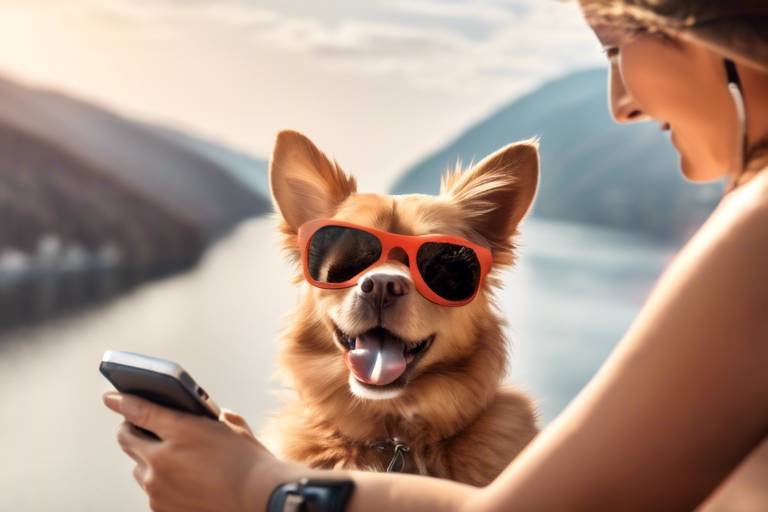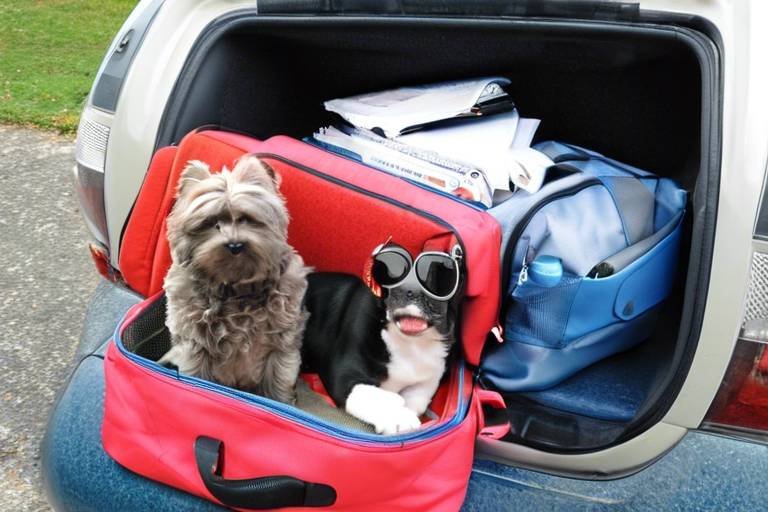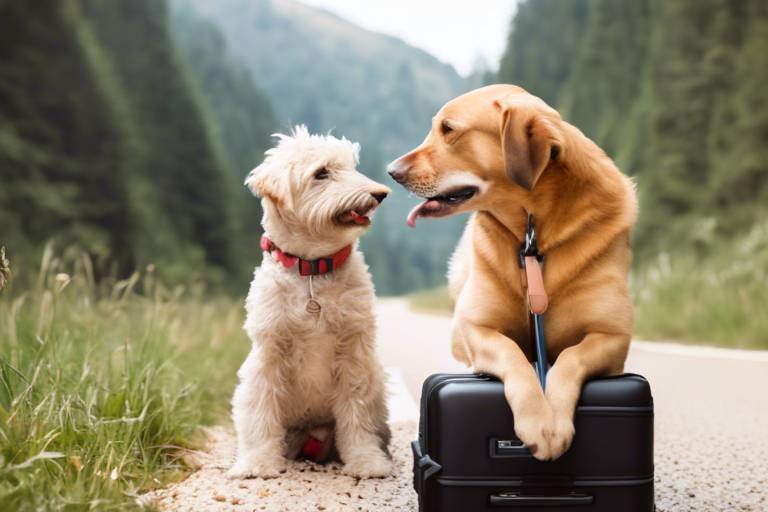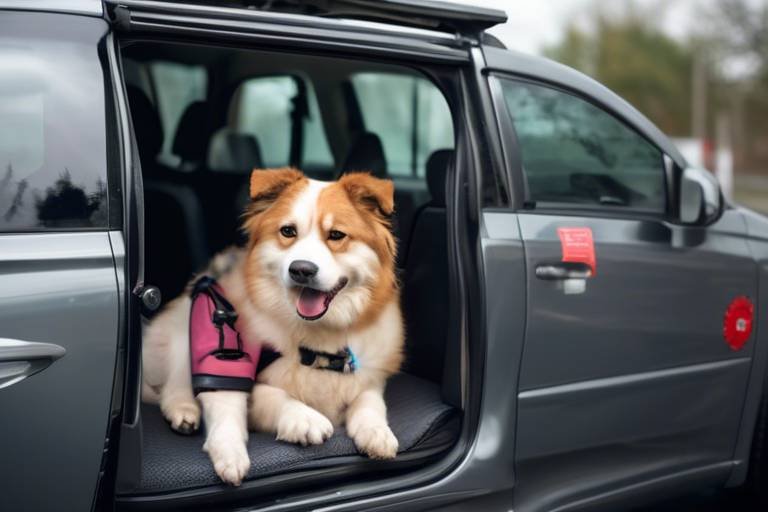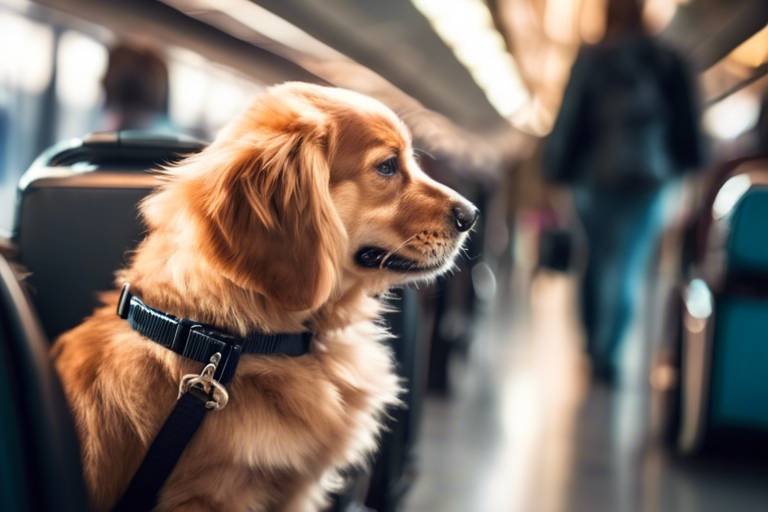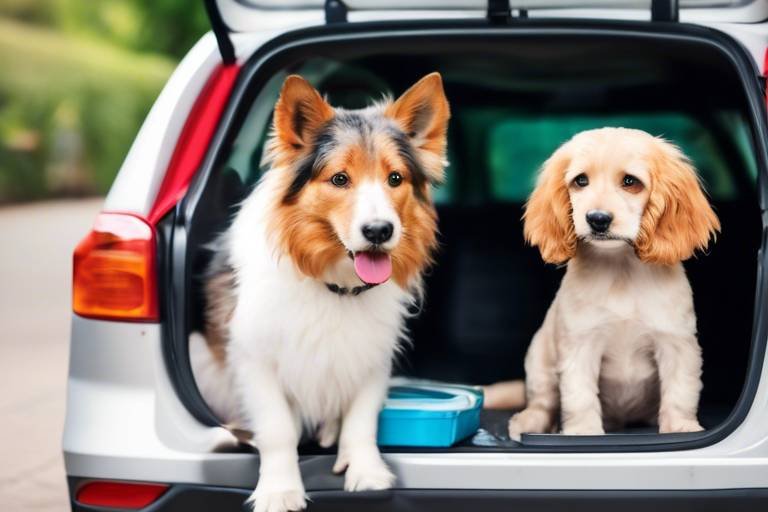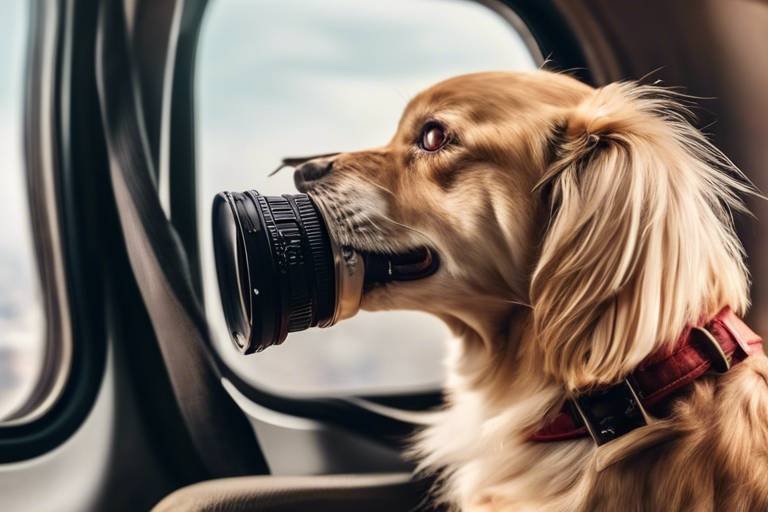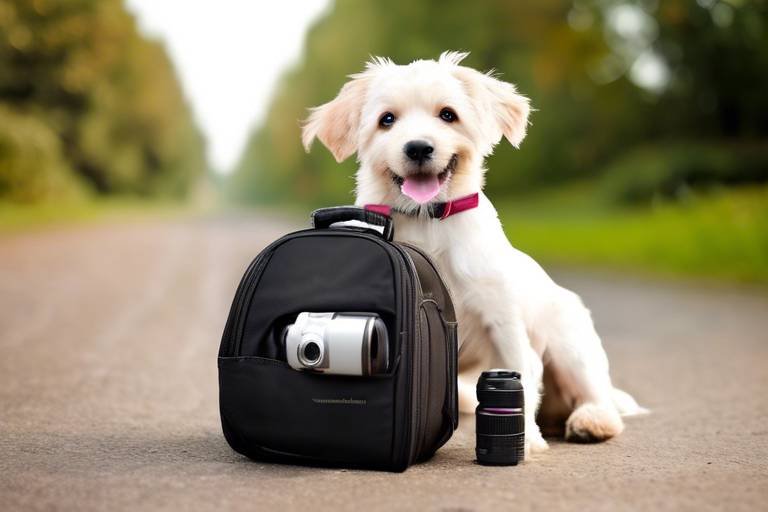How to Make Your Pet Feel Secure While Traveling
Traveling with your furry friend can be an exciting adventure, but it can also stir up a whirlwind of emotions for both you and your pet. Just like humans, pets can experience anxiety when faced with new environments, unfamiliar sounds, and the hustle and bustle of travel. So, how do we ensure that our beloved companions feel safe and comfortable during these journeys? The key lies in understanding their needs, preparing adequately, and creating a calm atmosphere. In this article, we’ll explore effective strategies that can transform your travel experience into a delightful escapade for both you and your pet.
Recognizing the signs of anxiety in pets is crucial for addressing their needs. Just like us, pets can exhibit various behaviors when they feel stressed. Some common signs include excessive barking, whining, hiding, or even destructive behavior. You might notice your dog pacing back and forth or your cat trying to escape to a safe spot. It’s essential to read these signals and respond appropriately. Imagine how you would feel in a crowded airport with loud noises and strange people everywhere—your pet feels the same way! By being attentive to their behavior, you can help alleviate their anxiety and make them feel more secure.
Preparation is key to a smooth travel experience. Before you embark on your journey, there are several essential steps you can take to ensure your pet feels at ease. First, make an appointment with your veterinarian to discuss any health concerns and ensure your pet is fit for travel. Additionally, gather all necessary supplies, such as food, water, and comfort items like their favorite blanket or toy. This will provide a sense of familiarity and comfort during your trip. Remember, a little planning goes a long way in creating a positive travel experience for your pet!
Selecting an appropriate carrier can significantly impact your pet's comfort. A carrier is not just a means of transport; it should be a safe haven for your pet. There are various types of carriers available, from soft-sided to hard-shell, and the right choice depends on your pet's size and temperament. For instance, a soft-sided carrier may be ideal for a calm cat, while a sturdy hard-shell option might be better for an energetic dog. When choosing a carrier, consider the following:
- Size: Ensure the carrier is spacious enough for your pet to stand, turn around, and lie down comfortably.
- Ventilation: Look for carriers with adequate airflow to keep your pet cool and comfortable.
- Security: Choose a carrier with secure latches to prevent any accidental escapes.
The size of the carrier should accommodate your pet comfortably. To find the perfect fit, measure your pet from the tip of their nose to the base of their tail, and from the top of their head to the ground. This way, you can choose a carrier that allows for movement without being too spacious, which can make them feel insecure. Remember, a snug fit can create a sense of security, much like a comforting hug.
Acclimating your pet to their carrier before travel can ease anxiety. Start by leaving the carrier open in a familiar space, allowing your pet to explore it at their own pace. You can place treats or their favorite toy inside to encourage them to enter. Gradually increase the time they spend in the carrier, and consider taking short trips around the block to help them associate the carrier with positive experiences. This simple technique can transform the carrier into a safe and familiar space, making your pet feel more secure during travel.
Car travel presents unique challenges for pet owners. To ensure a safe and enjoyable car ride for both you and your pet, it’s essential to keep them secure. Use a pet seatbelt or a secured carrier to prevent distractions while driving. Additionally, make frequent stops to let your pet stretch their legs and relieve themselves. Just like humans, pets can become restless during long journeys. If your pet tends to get car sick, consult with your veterinarian for remedies to keep them comfortable.
Air travel can be stressful for pets. To ensure their comfort and safety, it’s crucial to understand the specific requirements of flying with a pet. Each airline has its own policies regarding pet travel, so be sure to check these regulations before booking your flight. Some airlines allow pets in the cabin, while others require them to travel in the cargo hold. Knowing these details ahead of time can help you make informed decisions.
Understanding airline policies regarding pet travel is essential. Here are some key regulations to consider:
- Check if your pet is allowed in the cabin or must travel in cargo.
- Review size and weight restrictions for pets traveling in the cabin.
- Ensure your pet’s carrier meets the airline’s specifications.
Ensuring your pet's health and safety during travel is paramount. Before you travel, make sure your pet is up-to-date on vaccinations and obtain a health certificate from your veterinarian. This document may be required by airlines or hotels. Additionally, pack a travel kit that includes food, water, a leash, and any medications your pet may need. Taking these precautions can help ensure that your pet remains healthy and happy throughout the journey.
Q: How can I tell if my pet is anxious while traveling?
A: Look for signs such as excessive barking, whining, hiding, or destructive behavior. If your pet seems restless or tries to escape, they may be feeling anxious.
Q: What should I do if my pet gets sick during travel?
A: If your pet shows signs of motion sickness, consult your veterinarian for advice and possible medications to help ease their discomfort.
Q: Can I bring my pet in the cabin with me on a flight?
A: Many airlines allow small pets in the cabin, but you must check the specific airline's regulations and book a spot for your pet in advance.
Q: What items should I pack for my pet when traveling?
A: Pack food, water, a leash, waste bags, a first aid kit, and any medications your pet may need. Familiar items like their favorite blanket or toy can also provide comfort.

Understanding Pet Anxiety
When it comes to our furry friends, understanding their feelings is key to ensuring they have a pleasant experience, especially during travel. Just like us, pets can feel anxious, and recognizing the signs of this anxiety is crucial for addressing their needs effectively. Have you ever noticed your pet pacing back and forth, or perhaps they’ve hidden under the bed when they sense something is off? These behaviors can be indicators of stress. Common signs of anxiety in pets include:
- Excessive barking or meowing: This can signal discomfort or fear.
- Destructive behavior: Chewing furniture or scratching at doors can indicate that your pet is feeling overwhelmed.
- Changes in appetite: A sudden loss of interest in food can be a clear sign that something is bothering them.
- Pacing or restlessness: If your pet can’t seem to settle down, it may be a sign of anxiety.
- Hiding: Seeking out a quiet place to hide is a classic response to stress.
Understanding these signs is like having a cheat sheet to your pet's emotions. You might think of your pet as a little sponge, soaking up the environment around them. If they sense tension or chaos, they might react in ways that can be surprising or concerning. It's essential to observe their body language as well. A tucked tail, flattened ears, or wide eyes can all indicate that your furry companion is feeling uneasy.
Moreover, different pets may exhibit anxiety in various ways. For instance, while dogs might bark or whine, cats may choose to withdraw. It's important to tailor your approach based on your pet's unique personality and breed characteristics. Some pets may require more reassurance than others, much like how some people thrive in social situations while others prefer solitude.
In the context of travel, anxiety can be exacerbated by unfamiliar environments, loud noises, or even changes in routine. Think about how you feel when you're in a crowded airport or on a bumpy flight—it's no wonder our pets feel the same way! By recognizing the signs of anxiety, you can take proactive steps to help your pet feel more secure, whether that means providing a cozy blanket, a favorite toy, or simply spending extra time with them before the journey begins.
Ultimately, ensuring your pet's emotional well-being during travel is just as important as their physical safety. By being attentive to their needs and understanding the signs of anxiety, you can create a more harmonious travel experience for both you and your beloved companion.

Preparing for the Journey
When it comes to traveling with your furry friend, preparation is absolutely key to ensuring a smooth and enjoyable experience for both of you. You wouldn’t just jump into a car or onto a plane without a plan, right? The same goes for your pet! Taking the time to prepare can make all the difference in how your pet handles the journey. So, let’s dive into some essential steps that will help you and your pet embark on this adventure with confidence and ease.
First and foremost, it's critical to evaluate your travel method. Are you planning to drive or fly? Each mode of transportation comes with its own set of challenges and requirements. For instance, if you're driving, you might need to consider how long the journey will be and plan for breaks. If you're flying, understanding the airline's policies is essential. You don’t want any last-minute surprises that could cause stress for both you and your pet.
Next, packing the right supplies is vital. Think of it as packing for yourself, but with a few extra considerations for your pet. Here’s a quick checklist of items you should consider bringing along:
- Food and water: Bring enough for the entire journey, plus a little extra, just in case.
- Travel bowls: Collapsible bowls can save space and make it easier to feed your pet on the go.
- Leash and harness: A sturdy leash is a must, especially when you stop for breaks.
- Comfort items: Bring along their favorite blanket or toy to provide a sense of familiarity.
- First-aid kit: Accidents can happen, so it’s always good to be prepared.
Now, let’s talk about the importance of scheduling. Just like humans, pets thrive on routine. If you can, try to stick to their normal feeding and bathroom schedules. This can help minimize anxiety and keep your pet feeling secure. If you’re driving, plan your route to include regular stops for bathroom breaks and stretching. If flying, arrive at the airport early to give your pet time to acclimate to the environment.
Lastly, don’t forget about the health and safety preparations for your pet. A visit to the veterinarian before your trip can ensure that your pet is healthy and up-to-date on vaccinations. Some airlines require health certificates, especially for international travel, so make sure you have all the necessary documentation. It’s like having a passport for your pet! This will not only keep your pet safe but also give you peace of mind during your travels.
In summary, preparing for a journey with your pet involves understanding your travel method, packing the right supplies, maintaining a schedule, and ensuring your pet's health and safety. By taking these steps, you can help your pet feel more secure and comfortable, making the journey a pleasant experience for both of you.
Choosing the Right Carrier
When it comes to traveling with your furry friend, one of the most important decisions you'll make is choosing the right carrier. This isn't just a matter of convenience; the right carrier can significantly enhance your pet's comfort and security during the journey. Imagine yourself crammed into a tiny space for hours—it's not a pleasant thought, right? Your pet feels the same way! So, let’s dive into what you need to consider when selecting the perfect carrier.
First and foremost, you want to think about the type of carrier that suits your pet's needs. There are various options available, including hard-sided carriers, soft-sided carriers, and even backpacks designed for pets. Each type has its own advantages. For instance, hard-sided carriers tend to be more durable and easier to clean, while soft-sided ones often provide more comfort and can be easier to stow under airplane seats. Choosing the right type can make a world of difference in your pet's travel experience.
Another critical factor is the size of the carrier. It's essential that your pet has enough room to stand up, turn around, and lie down comfortably. A carrier that's too small can lead to anxiety and discomfort, while one that's too large might not provide the sense of security your pet needs. To find the right size, measure your pet from the tip of their nose to the base of their tail, and from the ground to the top of their head when they're standing. This will give you a good idea of the dimensions you need. Here’s a quick guide:
| Pet Size | Carrier Dimensions (L x W x H) |
|---|---|
| Small (up to 10 lbs) | 18" x 12" x 10" |
| Medium (10-25 lbs) | 24" x 16" x 14" |
| Large (25-50 lbs) | 30" x 20" x 19" |
Once you've settled on the right type and size, it’s time to think about familiarity. Acclimating your pet to their new carrier can greatly reduce anxiety during travel. Start by leaving the carrier open in your home, placing their favorite blanket or toy inside. This helps to create a positive association with the space. You might even consider feeding them their meals in the carrier or allowing them to explore it at their own pace. The more comfortable they feel, the easier your travels will be.
Lastly, don’t forget about ventilation and security. Ensure that the carrier has adequate ventilation to keep your pet cool and comfortable. Look for carriers with mesh panels or vents that allow for airflow. Additionally, check that the carrier has a secure locking mechanism. You wouldn’t want your adventurous pet making a break for it in the middle of an airport, would you? A secure carrier will provide peace of mind for both you and your pet.
In summary, choosing the right carrier involves considering the type, size, and familiarity for your pet, along with ensuring proper ventilation and security. By putting in the effort to select the ideal carrier, you're not just making a purchase; you're investing in your pet's comfort and happiness during your travels together. And remember, a happy pet means a happy journey!
Size and Comfort Considerations
When it comes to choosing the right carrier for your furry friend, size and comfort are paramount. Imagine cramming yourself into a tiny space for hours on end; it wouldn’t be pleasant, right? The same goes for your pet. A carrier that is too small can lead to discomfort, anxiety, and even injuries. Therefore, it's essential to measure your pet accurately to find a carrier that allows them to stand, turn around, and lie down comfortably.
To get started, you'll want to measure your pet's length and height. Here’s how you can do it:
- Length: Measure from the tip of the nose to the base of the tail.
- Height: Measure from the floor to the top of their head while they're standing.
- Weight: Weigh your pet to ensure the carrier can support their weight comfortably.
Once you have these measurements, you can begin your search for the right carrier. Look for one that is at least a few inches longer and taller than your pet's measurements to provide them with enough wiggle room. This space is not just about comfort; it also allows your pet to adjust their position during travel, which can significantly reduce anxiety.
Additionally, consider the material of the carrier. Soft-sided carriers are often more comfortable for pets, as they provide a cozy environment. However, if your pet is a chewer or tends to scratch, a hard-sided carrier may be a better choice. Here’s a quick comparison:
| Carrier Type | Comfort Level | Durability |
|---|---|---|
| Soft-Sided | High | Medium |
| Hard-Sided | Medium | High |
Lastly, don't forget to add some familiar items inside the carrier. A favorite blanket or toy can make a world of difference, helping your pet feel secure in an unfamiliar environment. By creating a cozy and safe space, you're not just providing a carrier; you're offering a little piece of home.
Familiarizing Your Pet with the Carrier
Getting your furry friend accustomed to their carrier is like preparing a child for their first day of school; it requires patience, understanding, and a little creativity. The carrier should become a safe haven rather than a source of anxiety. Start by placing the carrier in a familiar area of your home, like the living room or your pet's favorite spot. This will help them associate the carrier with comfort and safety.
Next, encourage your pet to explore the carrier on their own terms. You can do this by leaving the door open and placing their favorite blanket or toy inside. This not only makes the carrier more inviting but also allows your pet to investigate at their own pace. Imagine it as setting up a cozy little nook where they can retreat whenever they want. You might even consider using treats to entice them inside. Just a few small morsels can create positive associations with the carrier, making it a place they want to be.
Once your pet is comfortable entering the carrier, start closing the door for short periods. Gradually increase the duration, ensuring they remain calm. If your pet shows signs of distress, such as whining or scratching, it’s essential to backtrack and give them more time to adjust. Think of it like building a bridge; you want to make sure it’s stable before crossing over. During this process, you can also practice short car rides with the carrier to help your pet get used to the motion and sounds of travel.
Additionally, try to incorporate some fun activities around the carrier. Playtime can help reduce anxiety. For instance, you can engage in a game of fetch or tug-of-war near the carrier, so it becomes associated with fun and positive experiences. This way, your pet will start to see the carrier as a part of their adventure rather than a confinement.
In summary, familiarizing your pet with their carrier is a gradual process that involves creating a positive environment. By taking small, consistent steps, you can help your pet feel secure and ready for the journey ahead. Remember, the goal is to make the carrier a welcoming space that they associate with comfort and safety.
- How long should I take to familiarize my pet with the carrier?
It varies by pet, but typically a few days to a week of gradual exposure is ideal. - What if my pet refuses to enter the carrier?
Be patient and try using treats or toys to entice them. Never force them inside, as this can increase anxiety. - Can I use the carrier for other purposes?
Absolutely! Using the carrier for short trips or as a cozy resting place can help your pet feel more comfortable with it.
Traveling by Car
Car travel can be an exhilarating adventure, not just for you but also for your furry friend. However, it can also present unique challenges that require careful planning and consideration. First things first, have you ever noticed how your pet reacts when they see their favorite leash? That excitement can quickly turn into anxiety once the car doors close. To ensure a smooth ride, it’s essential to create a comfortable environment for your pet right from the start.
One significant aspect of traveling by car with your pet is ensuring their safety. Just like you wouldn’t drive without a seatbelt, your pet needs to be securely restrained during the journey. This not only protects them but also keeps you focused on the road. Consider investing in a quality pet seatbelt or a secure pet carrier that can be fastened in the back seat. It’s a small step that can make a huge difference in keeping your pet safe.
Now, let’s talk about comfort. Imagine being stuck in a cramped space for hours on end; it’s not a pleasant thought, right? The same goes for your pet. Make sure to take breaks every couple of hours to let them stretch their legs and relieve themselves. Not only does this help with physical comfort, but it also gives your pet a chance to explore new scents and sights, which can be a delightful distraction from the journey.
Another important factor to consider is the temperature inside the car. Pets can be sensitive to extreme temperatures, so always ensure the environment is comfortable. If it’s a hot day, keep the air conditioning on and ensure your pet has access to water. Conversely, if it’s chilly, make sure they are warm enough, perhaps with a cozy blanket or a pet-friendly jacket. Remember, a comfortable pet is a happy pet!
Before you hit the road, it’s also wise to prepare your pet for the journey. Just like you might pack snacks and entertainment for yourself, consider bringing along your pet’s favorite toys or blankets. These familiar items can provide comfort and help reduce anxiety. It’s like bringing a piece of home along for the ride!
Lastly, let’s not forget about the importance of identification. In the unfortunate event that your pet gets lost during a pit stop, having a collar with an ID tag and a microchip can be a lifesaver. Take a moment to double-check that your pet's information is up to date before you embark on your road trip.
In summary, traveling by car with your pet can be a delightful experience if you plan ahead. By ensuring their safety, comfort, and well-being, you can turn what might be a stressful situation into a fun adventure. After all, isn’t that what road trips are all about?
Q: How often should I stop for my pet during a long car trip?
A: It's best to stop every 2-3 hours to allow your pet to stretch, relieve themselves, and hydrate. This will help keep them comfortable and reduce anxiety.
Q: Can I let my pet stick their head out the window?
A: While it may look like fun, it’s unsafe. Debris can injure them, and sudden stops can lead to accidents. It's better to keep them inside the vehicle.
Q: What if my pet gets car sick?
A: If your pet shows signs of motion sickness, consult your veterinarian for advice. They may recommend medications or tips to help alleviate the symptoms.

Traveling by Air
Traveling by air can be a daunting experience, not just for you, but for your furry companions as well. Imagine being in a cramped space, surrounded by unfamiliar sounds and smells. It’s no wonder that many pets feel anxious during flights. To ensure your pet has a smooth journey, it's crucial to prepare adequately and understand the unique challenges that come with air travel.
First and foremost, airline regulations are a key aspect to consider. Each airline has its own set of rules regarding pet travel, and these can vary significantly. Some airlines allow pets in the cabin, while others may require them to be transported in the cargo hold. It's essential to check the specific policies of the airline you'll be flying with well in advance. This way, you can avoid any last-minute surprises that could lead to unnecessary stress for both you and your pet.
When it comes to flying with your pet, health and safety preparations are paramount. Before booking your flight, ensure your pet is up to date on vaccinations and has received a thorough health check from your veterinarian. Some airlines may require a health certificate issued by a vet, confirming that your pet is fit to fly. This document typically needs to be issued within a certain timeframe before travel, so be sure to plan accordingly.
Additionally, it’s wise to familiarize yourself with the specific requirements of the airline, which may include:
- Weight limits for pets traveling in the cabin
- Approved pet carriers that meet airline standards
- Documentation needed for international travel
Another critical factor is the temperature and environment conditions during the flight. Airlines have policies in place to ensure the safety of pets, but it’s always a good idea to double-check the weather conditions at both your departure and arrival locations. If it’s too hot or too cold, you might want to reconsider your travel plans or look for alternative arrangements.
To make your pet feel more comfortable during the flight, consider bringing along their favorite blanket or toy. Familiar scents can have a calming effect and help reduce anxiety. Additionally, try to maintain a calm demeanor yourself; pets can pick up on their owners’ emotions, so staying relaxed can help soothe their nerves.
Finally, don’t forget to plan for bathroom breaks! While many pets can hold it during a flight, it’s essential to be mindful of their needs. If your pet is traveling in the cabin, you’ll have more flexibility to take them out for a quick walk before boarding. However, if they’re traveling in the cargo hold, ensure they’ve had ample time to relieve themselves before the flight.
In summary, flying with your pet requires careful planning and consideration. By understanding airline regulations, ensuring your pet's health and safety, and preparing them for the journey, you can significantly reduce the stress of air travel for both you and your beloved companion.
Q: Can I take my pet in the cabin with me?
A: Many airlines allow pets to travel in the cabin if they meet certain size and weight restrictions. Always check with your airline for specific rules.
Q: What documents do I need to travel with my pet?
A: Most airlines require a health certificate signed by a veterinarian. Additionally, if traveling internationally, you may need an import permit or vaccination records.
Q: How can I keep my pet calm during the flight?
A: Bringing familiar items, maintaining a calm demeanor, and following a routine can help ease your pet's anxiety during air travel.
Airline Regulations
When it comes to flying with your furry friend, understanding is absolutely crucial. Each airline has its own set of rules and guidelines regarding pet travel, and being well-informed can make a world of difference in ensuring a smooth journey. Imagine preparing for a trip only to find out at the last minute that your pet doesn’t meet the airline’s requirements. That can be a real headache!
First and foremost, it's essential to check the specific policies of the airline you plan to fly with. Most airlines categorize pets into two main groups: those that travel in the cabin with you and those that are transported in the cargo hold. Here’s a quick breakdown:
| Travel Method | General Requirements |
|---|---|
| In-Cabin |
|
| Cargo Hold |
|
Additionally, some airlines may impose restrictions on specific breeds, particularly brachycephalic breeds like Bulldogs and Pugs, due to their respiratory issues. It’s always a good idea to verify this information to avoid any surprises at the airport.
Another important aspect to consider is the health documentation. Many airlines require a recent health certificate from a veterinarian, confirming that your pet is fit to fly. This certificate usually needs to be issued within a specific timeframe before your travel date, often within 10 days. Don’t forget to check if your pet's vaccinations are up to date, as some destinations have strict vaccination requirements.
Lastly, it’s wise to arrive at the airport early. Security checks can take time, and you want to ensure you have ample opportunity to address any last-minute issues. By being prepared and understanding the airline regulations, you can help make your pet’s travel experience as stress-free as possible. Remember, a little knowledge goes a long way in ensuring your beloved pet travels safely and comfortably!
Q: Can I bring my pet in the cabin with me?
A: Yes, many airlines allow pets in the cabin as long as they meet certain size and weight restrictions.
Q: Do I need a health certificate for my pet?
A: Yes, most airlines require a health certificate issued by a veterinarian before travel.
Q: Are there any breed restrictions for flying?
A: Some airlines have restrictions on specific breeds, particularly those prone to respiratory issues. Always check with your airline before booking.
Health and Safety Preparations
When it comes to traveling with your furry friend, ensuring their health and safety is a top priority. Just like us, pets can experience a range of health issues while traveling, and being prepared can make all the difference. Before you embark on your journey, it’s vital to check that your pet is in good health. A visit to the veterinarian is a smart first step. During this visit, you can confirm that your pet is up-to-date on vaccinations and discuss any specific health concerns that may arise during travel.
One of the most important documents you should obtain is a health certificate. This document certifies that your pet is healthy enough to travel and is often required by airlines or hotels. Make sure to schedule this vet appointment well in advance of your trip, as some health certificates are only valid for a limited time.
Additionally, if your pet is on any medications, ensure you have enough for the duration of your trip, plus a little extra just in case. It’s also wise to pack a small first aid kit tailored to your pet’s needs. This kit can include:
- Bandages
- Antiseptic wipes
- Fleas and ticks prevention
- Any regular medications
Another critical aspect is to familiarize yourself with the specific health regulations of your travel destination. Some places require pets to have certain vaccinations, or they may have quarantine laws. Researching these requirements ahead of time can prevent any last-minute surprises that could jeopardize your travel plans.
Lastly, don’t forget about your pet’s comfort during the journey. Bring along their favorite blanket or toy to help them feel at home. Just like a child, having a familiar item can significantly reduce anxiety and make the journey smoother. Remember, a little preparation goes a long way in ensuring that your pet travels safely and happily!
Q: Do I need a health certificate for my pet to travel?
A: Yes, many airlines and accommodations require a health certificate to ensure your pet is healthy enough to travel.
Q: What should I include in my pet’s travel first aid kit?
A: Your pet's first aid kit should include bandages, antiseptic wipes, flea and tick prevention, and any regular medications.
Q: How can I make my pet comfortable during travel?
A: Bring familiar items such as their favorite blanket or toy to help reduce anxiety and make them feel at home.
Frequently Asked Questions
- What are the signs that my pet is anxious while traveling?
Pets can show anxiety in various ways, such as excessive barking, whining, pacing, or hiding. You might also notice changes in their eating or drinking habits, or they may become more clingy than usual. Recognizing these signs early can help you take steps to soothe their nerves.
- How can I prepare my pet for a long journey?
Preparation is key! Start by getting your pet used to their travel carrier well in advance. Make it a cozy and familiar space by placing their favorite blanket or toy inside. Additionally, take short trips to acclimate them to the motion of travel and reward them with treats to create positive associations.
- What should I consider when choosing a carrier for my pet?
When selecting a carrier, size is vital. Your pet should be able to stand, turn around, and lie down comfortably. Look for carriers with proper ventilation and easy access. It’s also a good idea to choose one that is sturdy and secure to prevent any escape attempts!
- Are there special considerations for traveling by air with my pet?
Absolutely! Each airline has its own regulations regarding pet travel. Make sure to check their specific requirements, including carrier dimensions, health certificates, and vaccination records. Always book your pet's travel in advance to ensure a smooth process.
- What health preparations should I make for my pet before traveling?
Before you hit the road or take to the skies, ensure your pet is up-to-date on vaccinations and has a recent health check-up. Some destinations may require specific vaccinations or health certificates, so it's best to consult with your vet well in advance of your trip.
- Can I give my pet medication for anxiety during travel?
Consult your veterinarian about this. They may prescribe anti-anxiety medication or recommend natural remedies to help calm your pet during travel. Always test any medication at home before your trip to see how your pet reacts.





